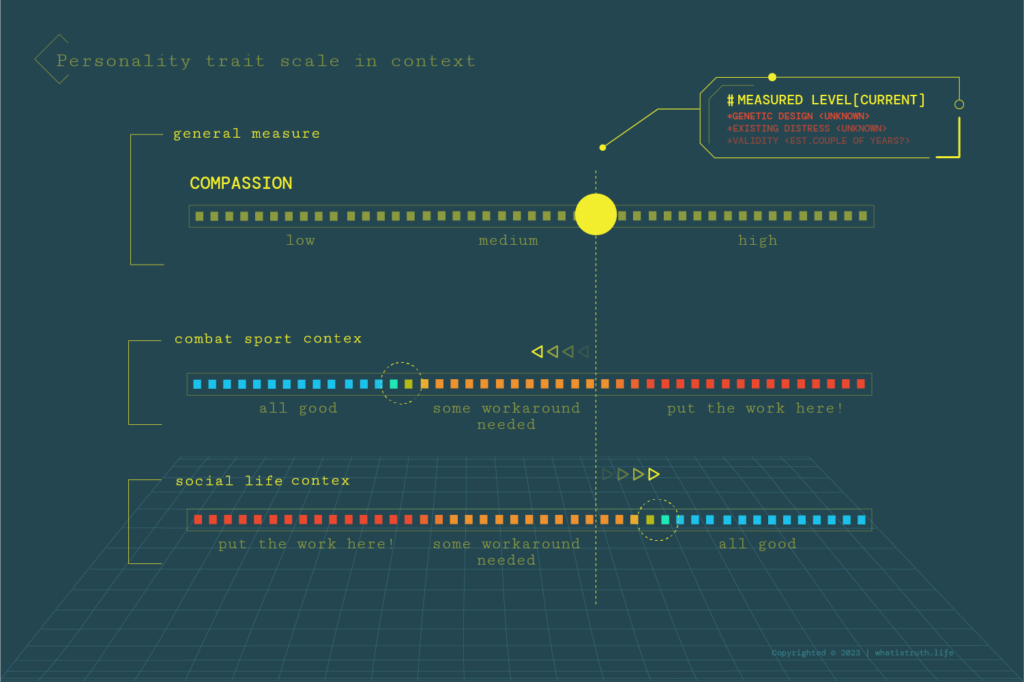Can personality change?
The understanding of personality has evolved much over time, and the factors involved are typically studied within the context of personality tests. The popularity of there tests has increased in recent decades, becoming an integral part of countless self-development programs across industries. People are so fascinated by personality tests because they make the abstract idea of personality more tangible by offering personality traits (or personality cards) as descriptors. These traits are not just empty labels; they’re proven to predict important life outcomes fairly consistently (Soto, 2021), including those involving career (Barrick & Mount, 1991) and health and well-being (Chopik, 2017). That raises the question of whether we can change our traits to better position ourselves to reach a desired outcome.
Traditionally, personality traits have been conceptualized as static elements that are difficult or even impossible to change, and this view dominated mainstream personality research for a long time. There is now, however, robust evidence that personality traits are dynamic characteristics that continue to change across one’s lifespan, sometimes due to conscious actions (Roberts et al., 2017) and sometimes in response to environmental changes (Bleidorn et al., 2018). Personality appears to be influenced by both non-biological and biological factors (Kandler et al., 2010), leading to lifelong plasticity of the personality traits, running beyond mood swings.
Why do we want to change?
The desire to change is as old as humanity itself, and it is commonly linked to dissatisfaction with one’s current state in life, be it financial, emotional, or economic circumstances (Hudson et al., 2019). If we’re not happy with where we are and what we have, we want to change it. Most of us intuitively extract patterns from our neighbourhood via observation of which personality cards have a better impact on success in life and well-being (Hudson & Roberts, 2014), forming an idea about what to change in ourselves to get to a better place.
In a worldwide survey, 60.40% of participants reported that they are trying to change certain aspects of their personalities, meaning more than half of the population links their unsatisfactory circumstances to their personalities. Interestingly, there are significant differences in proportion to how many people wish to change based on geolocation. The highest percentage was measured in Thailand (81.91%), and the lowest was in Kenya (21.41%) (Baranski et al., 2021). The differences can be due to several factors, including the density of the population, the level of digital intrusion, and access to media, all of which can reinforce the idea that certain perceived personality cards result in more success.
The context of personality scales
We use the Big5 or Five-Factor personality trait model across the site and in our tournament preparation module to describe the mental cards one must account for.
The five personality clusters of the Big5 model:
- Openness (perceptive, knowledgeable, cultured, artistic, curious, analytical traits)
- Conscientiousness (practical, cautious, serious, reliable, organised, careful, dependable, hardworking traits)
- Extraversion (sociable, talkative, active, spontaneous, adventurous, enthusiastic, person-oriented traits)
- Agreeableness (warm, trustful, courteous, agreeable, cooperative traits)
- Neuroticism (emotional, anxious, self-conscious, self-reflecting traits)
To accurately interpret a personality test’s outcome, it is essential to consider the person’s context and life goals. The most popular personality traits linked to a better outcome in life are the so-called socially desirable ones: high extraversion (outgoing, inviting), high agreeableness (kindness, cooperative), low neuroticism (emotionally stable), and high conscientiousness (organised, hardworking). A person with these qualities fits nicely into the corporate environment, displaying the features of a great co-worker. What makes these features popular is the context in which they are measured. On the other hand, the desired traits are quite different in other contexts. For example, a high score on agreeableness is not considered desirable for success as a combat athlete. All mental cards are goal-dependent, as they can be labelled desired or less desired only in the context of the person’s goal in life.
As another example, in the tournament preparation model, we labelled high compassion as something to work around—but only in the context of reaching a championship. There is nothing to fix or work around concerning compassion in other contexts, such as building caring, supportive relationships and a satisfactory life. The workaround focuses on awareness and the ability to control that trait during the tournament. Another example is emotional stability, which is strongly desired in the context of combat performance but is less desired when picking romantic partners where passion (derived from the same trait) is highly valued. So even this trait cannot be labelled as disadvantageous, as it brings great joy in life in different areas.

As seen on the above illustration, contemporary personality models describe personality traits as continuous scales. The basic concept of the Big5 model is that there is a finite set of variables (five) that exist in all humans, and we differ only in the degree in which we have that trait. Conversely, the earlier models, like the Jung-Meyer-Briggs 16-factor test, tended to offer personality types, suggesting an either/or combination between the mental cards—for example, classifying someone as either extrovert or introvert. While it is a valid concept for the sake of simplicity and a general approach toward everyday matters, for a deeper understanding of the self and for further self-development, this approach is less helpful as it suggests that we were built in a ‘set it and forget it’ manner.
How valid are personality tests?
Most of the arguments around the validity of personality tests come from unrealistic expectations about their results. These tests are rough concepts about people’s tendencies that help raise self-awareness and kickstart a deeper self-discovery journey (Stein and Swan, 2019). They’re not in any way a scientifically accurate description of someone’s mental design.
The main reason personality tests cannot be and likely never will be entirely accurate derives from the fluidity of the definition of personality itself. The currently accepted understanding views personality as the dynamic mental system of a person that serves as a motivational basis for behaviour (Allport, 1961). The key here is that it is dynamic, an ever-changing system with continuous interaction with the environment. Accordingly, by the time it’s measurable, it has already been adapted to the environment to a certain level, often referred to as characteristic adaptation (McAdams & Pals, 2016).
We cannot compare the original genetic disposition to what manifests as a personality at any given age because personality does not manifest without environmental impact. In other words, personality is inseparable from the environment that is shaping it. That also indicates that when it does not change, it is due to occupying relatively similar socioeconomic environment throughout life (Costa et al., 2019). Which gives a lot of credit to the say:
To change yourself, change environment.
Due to the self-reported nature of these tests, they also cannot comfortably distinguish between manifestations of personality traits or mental distresses. It is possible that what is measured by the test—for example, high competitiveness—is a manifestation of a long-term unmet need for acceptance. This also makes it questionable whether the measured traits are really traits or, in some cases, just symptoms of innate dynamics, including unmet needs and distresses. As these would distort the person’s natural way of doing things, when clinical treatment reaches a noticeable personality change in as short as six weeks of treatment, it is likely that it is not the personality that has changed but that a distorting effect has been eliminated (Ferguson, 2013).
Changing by biology
An increasing amount of evidence about personality change indicates that it happens gradually with time. That includes biological factors such as age maturation, as agreeableness and conscientiousness commonly increase with age. This pattern has been referred to as the maturity principle (Bleidorn et al., 2013; Bleidorn et al., 2019). Conversely, a temporary dip in socially relevant traits such as conscientiousness, extraversion, and agreeableness during adolescence (Denissen et al., 2013) makes teenagers withdrawn and somewhat hectic. This is known as the disruption hypothesis, although most research considers this life stage as a critical period for personality development (Bleidorn et al., 2020).
Another prominent example of how biology drives personality changes comes from the so-called challenge hypothesis that describes how testosterone, that is linked to dominance/status seeking, risk-taking, and mating drive, changes with the circumstances of the person. The level of testosterone decreases when a man is in a relationship and further decreases when he becomes a father, but it increases again when he get divorced—showing that the biological process behind personality dynamically interacts with the environment, helping us adaptively change as needed (Grebe et al., 2019).
Changing by daily experiences
Personality change also happens via the accumulation of daily experiences, making our life circumstances extremely important in terms of growth plans. Personality change can occur as a result of drastic life events—such as the death of loved ones, natural disasters like the pandemic, or falling in love—as these events take over the daily experience (Damian et al., 2021). But personality change can also be induced by very common life events, such as a promotion, a marriage, moving, etc. More importantly, recent results show that daily moods, once considered to be fleeting, can turn into permanent states when habitual. Moods can change our biology, reinforcing personality trait formation (Hudson, 2019).
This is where things get exciting. These results show that not only can people change, they will change with time; moreover, they change due to their daily exposure to certain experiences.
That is good news if someone desires, for example to be more agreeable (kindness, cooperative). They will become kinder if they spend significant time in a caring position. However, it is bad news if someone in an abusive relationship thinks hard times will fade without impact. Those times will have an impact, and the personality change could last for a while—but not forever, as the dynamic exchange between personality and environment will continue.
Another interesting result from recent research shows how a person’s handling of environmental pressure could eliminate its impact. In Wrzus’ study (2021), daily hustle increased a person’s neuroticism level within a couple of years, likely due to a biological change that brought a shift in behaviour. But the change only happened in the case of those participants who reacted stressfully to the hustle; the daily hustle alone did not increase neuroticism. With an effective coping mechanism in place, the impact of the environment can be buffered. In the context of combat sports and specifically for regular competitors, this is a very significant result.
First, it destroys the old myth that you’ll inevitably toughen up if you’re exposed to the tournament hustle regularly. Without a coping mechanism, you might become more sensitive to it, with an increasing inhibitory impact on your performance. Second, it shows that a coping mechanism can protect you from the stress of a competitive lifestyle.
Changing intentionally
The ultimate question is this: Can we intentionally change our personality cards in the desired direction? Research shows that we can. It’s not just random life circumstances that can change our personality; purposefully set-up circumstances can do the same. Effective change in the levels of any personality trait requires us to actively engage in tasks and challenges that pull our behaviour toward the desired trait levels (Stieger et al., 2021). This will trigger biological changes that reinforce and engrain the personality changes. The most important note here is that just wishing to change does nothing. It does not create biological changes. Only when the drive is accompanied by a conscious effort that the focused behaviour brings change via useful exposure (Hudson 2019).
Nothing changes without action!
Summary
Over the past few decades, research on personality development has pushed the field toward a better understanding of how personalities can and do change across one’s lifespan in response to life experiences and innate biological changes. It has been widely accepted that personality is a dynamic concept, as opposed to earlier theories suggesting we are born a particular way and die the same way. Instead, we can change our traits with conscious action and intentional exposure, shifting our mental cards in the desired direction. Our tournament preparation series utilises the above contemporary knowledge on how to change oneself in the desired direction, bringing personal dreams one step closer to reality.
References
Allport, G. W. (1961). Pattern and growth in personality.
Baranski, E., Gardiner, G., Lee, D., & Funder, D. C. (2021). Who in the world is trying to change their personality traits? Volitional personality change among college students in six continents. Journal of Personality and Social Psychology, 121(5), 1140.
Hudson, N. W., & Roberts, B. W. (2014). Goals to change personality traits: Concurrent links between personality traits, daily behavior, and goals to change oneself. Journal of Research in Personality, 53, 68-83.
Moyle, P., & Hackston, J. (2018). Personality assessment for employee development: Ivory tower or real World?. Journal of Personality Assessment, 100(5), 507-517.
Stein, R., & Swan, A. B. (2019). Evaluating the validity of Myers‐Briggs Type Indicator theory: A teaching tool and window into intuitive psychology. Social and Personality Psychology Compass, 13(2), e12434.
Helson, R., Kwan, V. S., John, O. P., & Jones, C. (2002). The growing evidence for personality change in adulthood: Findings from research with personality inventories. Journal of research in personality, 36(4), 287-306.
Costa Jr, P. T., McCrae, R. R., & Löckenhoff, C. E. (2019). Personality across the life span. Annual review of psychology, 70, 423-448.
Ferguson, E. (2013). Personality is of central concern to understand health: towards a theoretical model for health psychology. Health Psychology Review, 7(sup1), S32-S70.
Grebe, N. M., Sarafin, R. E., Strenth, C. R., & Zilioli, S. (2019). Pair-bonding, fatherhood, and the role of testosterone: A meta-analytic review. Neuroscience & Biobehavioral Reviews, 98, 221-233.
Hudson, N. W., Derringer, J., & Briley, D. A. (2019). Do people know how they’ve changed? A longitudinal investigation of volitional personality change and participants’ retrospective perceptions thereof. Journal of Research in Personality, 83, 103879.
Hudson, Nathan W., Daniel A. Briley, William J. Chopik, and Jaime Derringer. “You have to follow through: Attaining behavioral change goals predicts volitional personality change.” Journal of Personality and Social Psychology 117, no. 4 (2019): 839.
Goldberg, L. R. 1992. The development of markers for the Big-Five factor structure. Psychological Assessment, 4: 26–42.
Wrzus, C., Luong, G., Wagner, G. G., & Riediger, M. (2021). Longitudinal coupling of momentary stress reactivity and trait neuroticism: Specificity of states, traits, and age period. Journal of personality and social psychology, 121(3), 691.
Bleidorn, W., Hopwood, C. J., Back, M. D., Denissen, J. J., Hennecke, M., Hill, P. L., … & Zimmermann, J. (2021). Personality trait stability and change. Personality Science, 2, 1-20.
Roberts, B. W., Kuncel, N. R., Shiner, R., Caspi, A., & Goldberg, L. R. (2007). The power of personality: The comparative validity of personality traits, socioeconomic status, and cognitive ability for predicting important life outcomes. Perspectives on Psychological science, 2(4), 313-345.
Roberts, B. W., Luo, J., Briley, D. A., Chow, P. I., Su, R., & Hill, P. L. (2017). A systematic review of personality trait change through intervention. Psychological Bulletin, 143(2), 117.
Bleidorn, W., Hopwood, C. J., Back, M. D., Denissen, J. J., Hennecke, M., Jokela, M., … & Zimmermann, J. (2020). Longitudinal experience–wide association studies—A framework for studying personality change. European Journal of Personality, 34(3), 285-300.
Costa Jr, P. T., McCrae, R. R., & Löckenhoff, C. E. (2019). Personality across the life span. Annual review of psychology, 70, 423-448.
Bleidorn, W., Klimstra, T. A., Denissen, J. J., Rentfrow, P. J., Potter, J., & Gosling, S. D. (2013). Personality maturation around the world: A cross-cultural examination of social-investment theory. Psychological science, 24(12), 2530-2540.
Schwaba, T., & Bleidorn, W. (2018). Individual differences in personality change across the adult life span. Journal of personality, 86(3), 450-464.
Stieger, M., Flückiger, C., Rüegger, D., Kowatsch, T., Roberts, B. W., & Allemand, M. (2021). Changing personality traits with the help of a digital personality change intervention. Proceedings of the National Academy of Sciences, 118(8), e2017548118.
Damian, R. I., Serrano, S., & Hill, P. L. (2021). Hurricane exposure and personality development. Journal of personality, 89(1), 35-49.
McAdams, D. P., & Pals, J. L. (2006). A new Big Five: fundamental principles for an integrative science of personality. American psychologist, 61(3), 204.


